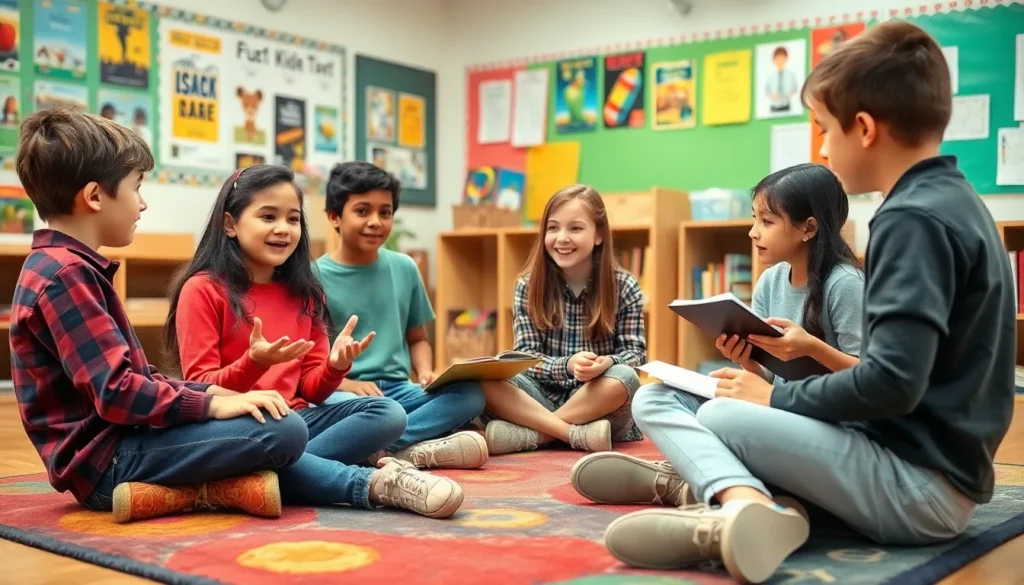Table of Contents
ToggleImagine a room buzzing with excitement, where students dive into books like they’re diving into a pool on a hot summer day. That’s the magic of literature circles! These collaborative reading groups transform the mundane task of reading into a lively discussion, sparking creativity and critical thinking.
Overview of Literature Circles
Literature circles are small, student-led reading groups designed to enhance comprehension and engagement. Students choose texts based on personal interests, fostering a sense of ownership in their learning. Various roles within the circle, such as discussion leader or summarizer, promote active participation and accountability among group members.
These circles invite diverse perspectives, enriching discussions as individuals share insights and interpretations. Students learn to articulate their thoughts clearly, enhancing communication skills in the process. Frequent meetings allow participants to reflect on readings and establish deeper connections with the text.
Literature circles also cultivate a collaborative atmosphere, where students build relationships through shared reading experiences. Teachers play a supportive role, facilitating discussions and guiding students in exploring challenging themes or concepts.
Research indicates that literature circles can improve critical thinking skills and elevate motivation levels. As students engage with texts collaboratively, their understanding of narrative elements and character development deepens. This approach not only benefits individual readers but also creates a community of learners.
Literature circles transform reading into an interactive journey. They encourage students to explore literature through discussions, fostering a love for reading and critical analysis.
Benefits of Literature Circles

Literature circles provide numerous advantages for students, fostering academic and social growth through collaborative learning experiences.
Enhanced Comprehension Skills
Students deepen their comprehension skills through literature circles by actively engaging with texts. Discussions allow members to express thoughts, posing questions that encourage exploration of themes and character development. Sharing diverse perspectives provides multiple interpretations of the same material. Participants also enhance critical thinking abilities, as they analyze characters’ motivations and plot structures. Annotating texts during meetings reinforces understanding, supporting retention of key concepts. Research from the National Reading Panel indicates that such interactions lead to significant improvements in reading comprehension over time. Establishing a supportive environment where students feel comfortable sharing ideas cultivates confident readers who appreciate literature further.
Promoting Collaboration
Literature circles effectively promote collaboration among peers, creating learning communities where teamwork thrives. Students assume specific roles, such as discussion leader or critic, facilitating organized conversations and accountability. These structured roles encourage participation from all members, ensuring everyone contributes to the learning process. Communication skills improve as students articulate their thoughts and actively listen to others. Additionally, collaboration fosters respect for differing opinions, enriching the group dynamic. Group discussions also enable students to develop negotiation skills as they reach consensus on interpretations. The collective effort nurtures a sense of belonging, motivating students to engage with literature enthusiastically.
Key Components of Literature Circles
Literature circles consist of several key components that facilitate effective collaboration and engagement among students.
Roles in Literature Circles
Participants in literature circles take on specific roles to enhance discussion and accountability. Each role, including discussion leader, summarizer, and connector, focuses on different aspects of the reading experience. Discussion leaders guide conversations, ensuring all members contribute insights. Summarizers succinctly recap chapters, highlighting crucial points. Connectors link themes from the text to broader contexts, enriching understanding. Roles rotate after reading sessions, promoting equity in participation and fostering a sense of shared responsibility.
Selection of Texts
Choosing texts plays a critical role in literature circles. Students select books based on personal interests and reading levels, which strengthens motivation and investment in the material. Teachers may provide a list of diverse options to ensure a variety of genres and themes. Engaging with texts that resonate strongly with students encourages deeper discussions and insights. This choice empowers students, increasing their ownership of the learning process and enhancing enjoyment in reading.
Implementing Literature Circles in the Classroom
Effective implementation of literature circles requires careful planning. Teachers can take several steps to ensure success.
Step-by-Step Guide
- Select engaging texts that align with students’ interests and reading levels.
- Form groups of 4 to 6 students to encourage participation.
- Assign specific roles such as discussion leader, summarizer, and connector to each group member.
- Schedule regular meetings for discussions, allowing adequate time for reading.
- Encourage students to reflect on their readings and share insights.
- Rotate roles after each session to promote equity.
Each of these steps forms a structure that enhances engagement and comprehension while maximizing collaboration.
Common Challenges and Solutions
Teachers may encounter challenges when implementing literature circles. Some students might resist group work or dominate discussions.
To address resistance, educators can create a safe environment by modeling appropriate discussion behaviors. Additionally, monitoring group dynamics helps identify and rectify imbalances in participation.
Another challenge includes selecting appropriate texts. Providing a range of options ensures that all students remain interested.
Regular check-ins with groups can also support ongoing engagement and understanding. These strategies effectively mitigate challenges and foster positive experiences in literature circles.
Literature circles stand out as a powerful tool for enhancing student engagement and comprehension. By transforming reading into a collaborative experience, they foster a love for literature and critical thinking. Students not only explore texts deeply but also develop essential communication and teamwork skills.
The roles within literature circles ensure that every participant contributes actively, promoting accountability and respect for diverse viewpoints. This collaborative environment nurtures relationships and creates a sense of belonging among students. As they share insights and interpretations, their understanding of narrative elements and character development deepens.
Implementing literature circles effectively can lead to significant improvements in reading comprehension and motivation. With the right strategies in place, teachers can create vibrant learning communities where students thrive academically and socially through shared reading experiences.




